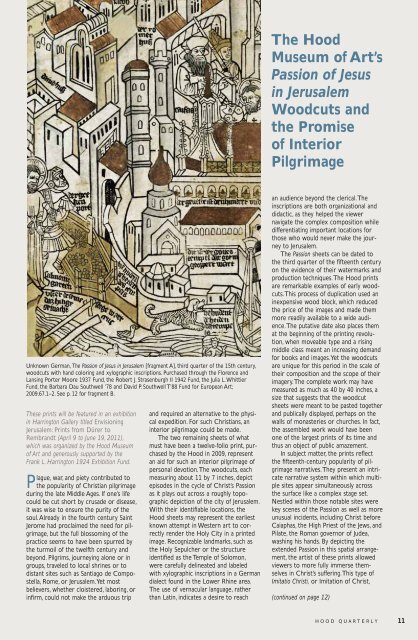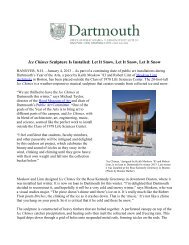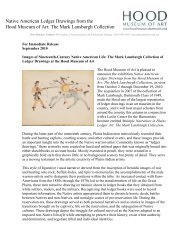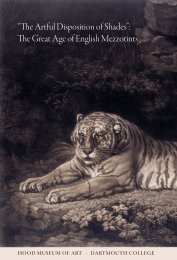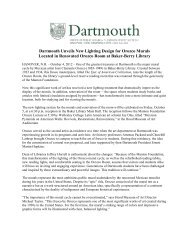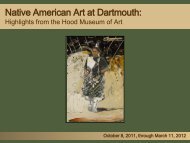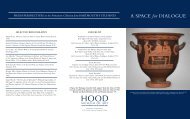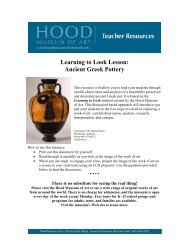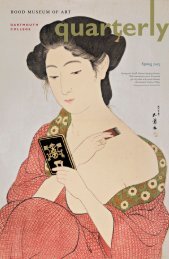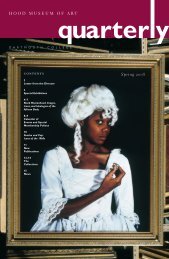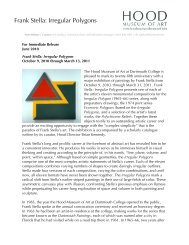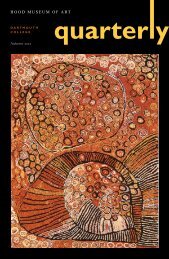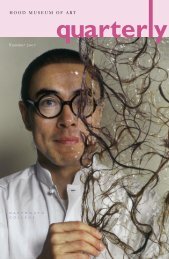Spring/Summer 2011 - Hood Museum of Art - Dartmouth College
Spring/Summer 2011 - Hood Museum of Art - Dartmouth College
Spring/Summer 2011 - Hood Museum of Art - Dartmouth College
Create successful ePaper yourself
Turn your PDF publications into a flip-book with our unique Google optimized e-Paper software.
The <strong>Hood</strong><br />
<strong>Museum</strong> <strong>of</strong> <strong>Art</strong>’s<br />
Passion <strong>of</strong> Jesus<br />
in Jerusalem<br />
Woodcuts and<br />
the Promise<br />
<strong>of</strong> Interior<br />
Pilgrimage<br />
Unknown German, The Passion <strong>of</strong> Jesus in Jerusalem [fragment A], third quarter <strong>of</strong> the 15th century,<br />
woodcuts with hand coloring and xylographic inscriptions. Purchased through the Florence and<br />
Lansing Porter Moore 1937 Fund, the Robert J. Strasenburgh II 1942 Fund, the Julia L. Whittier<br />
Fund, the Barbara Dau Southwell ’78 and David P. Southwell T’88 Fund for European <strong>Art</strong>;<br />
2009.67.1–2. See p. 12 for fragment B.<br />
These prints will be featured in an exhibition<br />
in Harrington Gallery titled Envisioning<br />
Jerusalem: Prints from Dürer to<br />
Rembrandt (April 9 to June 19, <strong>2011</strong>),<br />
which was organized by the <strong>Hood</strong> <strong>Museum</strong><br />
<strong>of</strong> <strong>Art</strong> and generously supported by the<br />
Frank L. Harrington 1924 Exhibition Fund.<br />
Plague, war, and piety contributed to<br />
the popularity <strong>of</strong> Christian pilgrimage<br />
during the late Middle Ages. If one’s life<br />
could be cut short by crusade or disease,<br />
it was wise to ensure the purity <strong>of</strong> the<br />
soul. Already in the fourth century Saint<br />
Jerome had proclaimed the need for pilgrimage,<br />
but the full blossoming <strong>of</strong> the<br />
practice seems to have been spurred by<br />
the turmoil <strong>of</strong> the twelfth century and<br />
beyond. Pilgrims, journeying alone or in<br />
groups, traveled to local shrines or to<br />
distant sites such as Santiago de Compostella,<br />
Rome, or Jerusalem. Yet most<br />
believers, whether cloistered, laboring, or<br />
infirm, could not make the arduous trip<br />
and required an alternative to the physical<br />
expedition. For such Christians, an<br />
interior pilgrimage could be made.<br />
The two remaining sheets <strong>of</strong> what<br />
must have been a twelve-folio print, purchased<br />
by the <strong>Hood</strong> in 2009, represent<br />
an aid for such an interior pilgrimage <strong>of</strong><br />
personal devotion. The woodcuts, each<br />
measuring about 11 by 7 inches, depict<br />
episodes in the cycle <strong>of</strong> Christ’s Passion<br />
as it plays out across a roughly topographic<br />
depiction <strong>of</strong> the city <strong>of</strong> Jerusalem.<br />
With their identifiable locations, the<br />
<strong>Hood</strong> sheets may represent the earliest<br />
known attempt in Western art to correctly<br />
render the Holy City in a printed<br />
image. Recognizable landmarks, such as<br />
the Holy Sepulcher or the structure<br />
identified as the Temple <strong>of</strong> Solomon,<br />
were carefully delineated and labeled<br />
with xylographic inscriptions in a German<br />
dialect found in the Lower Rhine area.<br />
The use <strong>of</strong> vernacular language, rather<br />
than Latin, indicates a desire to reach<br />
an audience beyond the clerical. The<br />
inscriptions are both organizational and<br />
didactic, as they helped the viewer<br />
navigate the complex composition while<br />
differentiating important locations for<br />
those who would never make the journey<br />
to Jerusalem.<br />
The Passion sheets can be dated to<br />
the third quarter <strong>of</strong> the fifteenth century<br />
on the evidence <strong>of</strong> their watermarks and<br />
production techniques. The <strong>Hood</strong> prints<br />
are remarkable examples <strong>of</strong> early woodcuts.<br />
This process <strong>of</strong> duplication used an<br />
inexpensive wood block, which reduced<br />
the price <strong>of</strong> the images and made them<br />
more readily available to a wide audience.<br />
The putative date also places them<br />
at the beginning <strong>of</strong> the printing revolution,<br />
when moveable type and a rising<br />
middle class meant an increasing demand<br />
for books and images. Yet the woodcuts<br />
are unique for this period in the scale <strong>of</strong><br />
their composition and the scope <strong>of</strong> their<br />
imagery. The complete work may have<br />
measured as much as 40 by 40 inches, a<br />
size that suggests that the woodcut<br />
sheets were meant to be pasted together<br />
and publically displayed, perhaps on the<br />
walls <strong>of</strong> monasteries or churches. In fact,<br />
the assembled work would have been<br />
one <strong>of</strong> the largest prints <strong>of</strong> its time and<br />
thus an object <strong>of</strong> public amazement.<br />
In subject matter, the prints reflect<br />
the fifteenth-century popularity <strong>of</strong> pilgrimage<br />
narratives. They present an intricate<br />
narrative system within which multiple<br />
sites appear simultaneously across<br />
the surface like a complex stage set.<br />
Nestled within those notable sites were<br />
key scenes <strong>of</strong> the Passion as well as more<br />
unusual incidents, including Christ before<br />
Caiaphas, the High Priest <strong>of</strong> the Jews, and<br />
Pilate, the Roman governor <strong>of</strong> Judea,<br />
washing his hands. By depicting the<br />
extended Passion in this spatial arrangement,<br />
the artist <strong>of</strong> these prints allowed<br />
viewers to more fully immerse themselves<br />
in Christ’s suffering. This type <strong>of</strong><br />
Imitatio Christi, or Imitation <strong>of</strong> Christ,<br />
(continued on page 12)<br />
HOOD QUARTERLY 11


